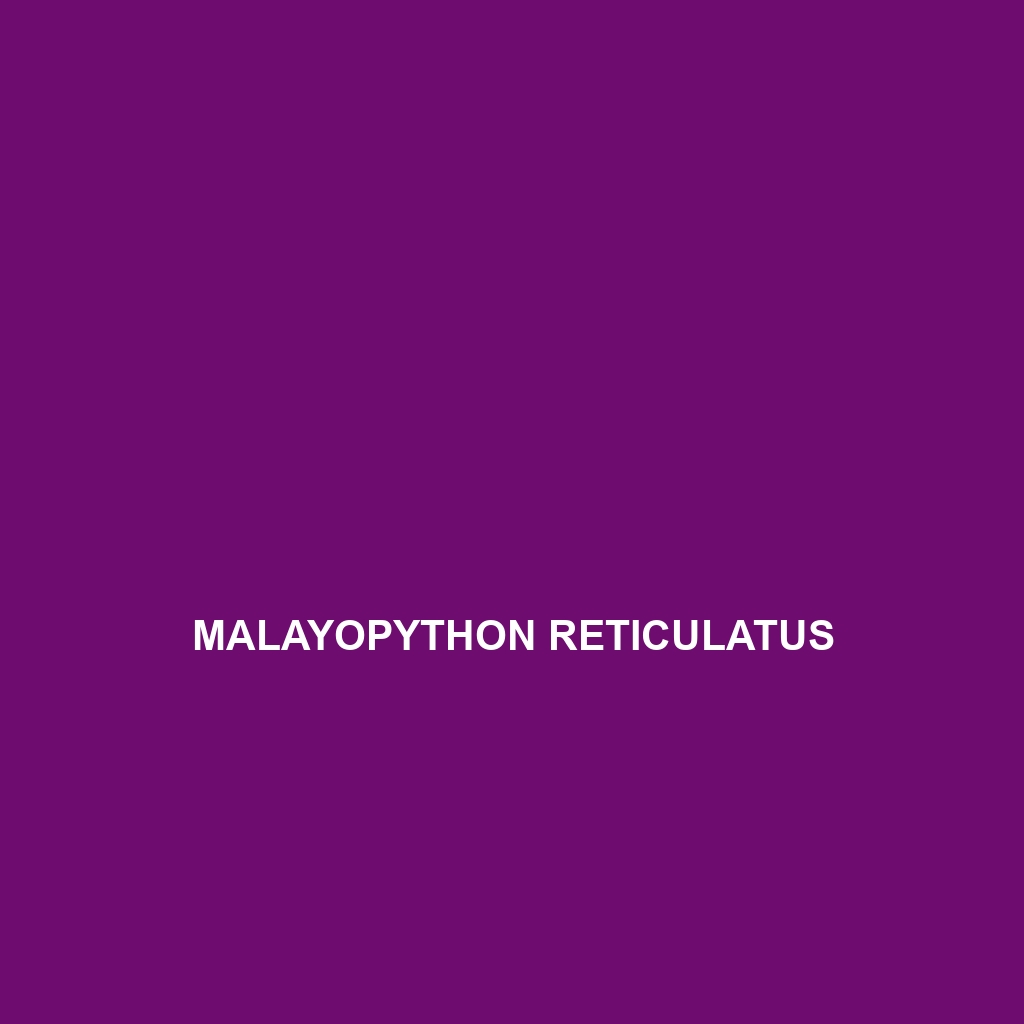Common Name
Malayopython reticulatus
Scientific Name
Malayopython reticulatus
Habitat
Malayopython reticulatus, commonly known as the reticulated python, thrives in a diversity of habitats across Southeast Asia. This species is primarily found in lush rainforests, beautiful savannas, and sometimes in temperate forests. They inhabit regions from the thick jungles of Indonesia to the coastal areas of the Philippines. Characterized by a tropical climate, these geographical areas experience substantial rainfall and warm temperatures that foster a rich biodiversity. Reticulated pythons are also found in areas near freshwater sources such as rivers, swamps, and lakes, allowing them to maintain a necessary hydration level. Additionally, they occasionally venture into disturbed environments, highlighting their adaptability to various ecological conditions.
Physical Characteristics
Reticulated pythons are notable for their impressive size, being among the longest snake species in the world. Adult specimens commonly reach lengths between 10 to 20 feet, with some individuals exceeding 25 feet. Their robust, elongated bodies are covered in a complex pattern of dark brown, yellow, and black markings, which not only provide camouflage but also lend the species its name. One can identify the Malayopython reticulatus by its distinct chain-like design along its dorsal side. Additionally, they have well-developed heat-sensing pits located on their jaws, enhancing their ability to hunt warm-blooded prey, making them proficient ambush predators.
Behavior
The reticulated python exhibits various intriguing behaviors. As primarily nocturnal creatures, they are more active during the night, engaging in hunting or basking activities. During the day, they often seek shelter in trees or dense foliage, maintaining a low profile to avoid predators. Socially, reticulated pythons are generally solitary, coming together only during mating rituals. Remarkably, they showcase a form of ambush predation, lying still for hours until potential prey approaches. After a period of quiet observation, they strike rapidly, employing both speed and strength to constrict their captures. Their adaptability allows them to thrive in a wide range of environments, making their behavioral patterns particularly interesting for study.
Diet
As strict carnivores, Malayopython reticulatus primarily feeds on a diet consisting of mammals and birds. Their typical prey includes rodents, pigs, and even small deer. They are known for their ability to consume large prey items, reportedly capable of taking down animals bigger than themselves due to their impressive constriction abilities. Their feeding patterns often involve hunting during the night, where they can leverage their camouflaged appearance to ambush unsuspecting potential meals. The reticulated python utilizes its powerful jaws and muscular body to subdue and swallow prey whole, showcasing their remarkable adaptations as apex predators in their ecosystems.
Reproduction
Reproduction occurs in the breeding season, typically aligned with the warm and wet monsoon season when potential mates are more abundant. After a gestation period ranging from 60 to 90 days, female reticulated pythons lay between 15 to 100 eggs in a single clutch. Remarkably, females exhibit unique maternal behavior by coiling around their eggs to provide warmth, ensuring a stable temperature for the developing embryos. Hatchlings typically emerge after about 90 days, measuring approximately 30 inches long. The young snakes are immediately self-sufficient and begin hunting small prey shortly after birth, displaying the independent lifestyle characteristic of their species.
Conservation Status
Currently, the conservation status of Malayopython reticulatus is categorized under ‘Least Concern’ according to the International Union for Conservation of Nature (IUCN). Although the species is widespread and relatively abundant, it faces threats from habitat loss due to deforestation and illegal wildlife trade. Conservation efforts are crucial to ensure sustainable populations. Organizations are working to protect their habitats and mitigate illegal hunting activities that threaten their existence in the wild.
Interesting Facts
Several fascinating traits define the Malayopython reticulatus. Firstly, they are renowned for their impressive swimming abilities and can often be found in bodies of water, sometimes even inhabiting marine habitats. Additionally, these pythons are among the longest snakes in the world, with records indicating lengths of over 30 feet, showcasing one of nature’s wonders. Furthermore, in various cultures, reticulated pythons hold significant symbolic meanings, often regarded as auspicious creatures or valued for their skins.
Role in Ecosystem
The ecological role of Malayopython reticulatus is indispensable. As a top predator, they regulate prey populations, contributing to the overall balance of their ecosystems. By controlling smaller mammal populations, they help maintain biodiversity and health within their habitats. Additionally, as both predator and prey, reticulated pythons participate in complex food webs, reinforcing their significance as keystone species. Their presence indicates a well-functioning ecosystem, and their decline could lead to unforeseen impacts on the environmental equilibrium.
